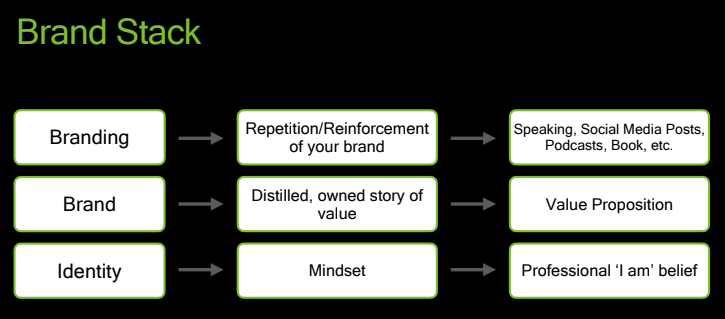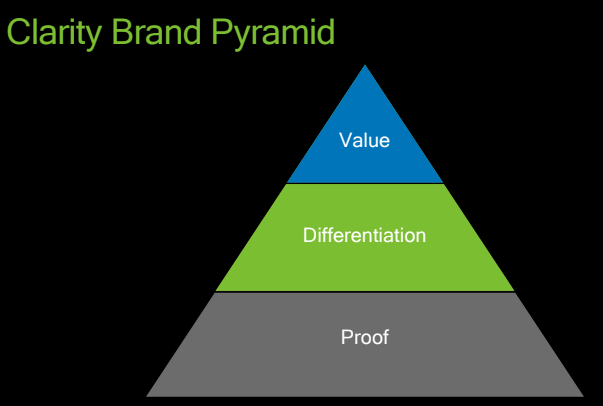
For this blog I sat with an expert in Professional Branding, Chris Haase from Clarity Silicon Valley.
So how do we actually success with our branding? Keep reading to know the answer.
What Is The Difference Between a Personal Brand And a Professional Brand?
According to Chris, a Personal Brand is different from a Professional Brand. He mentioned that Personal Brand is what everyone uses a lot in terms of how they describe what their brand is.
However, he found out that personal and professional brands are two different things.
A professional brand has only one context while a personal brand has many different contexts:
- Family Context
- Partner or Spouse Context
- Hobbies Context
- Philanthropic Efforts
- Professional Efforts
The top value that we deliver in each of those contexts is different whereas a company has only one context.
So Chris believes in being specific when it comes to brand. He also pointed out not to use terms or phrases that are not clear.
For example, if he says the word “shoe”, you might have a different type of shoe compared to the one he has in his mind.
The 3 Parts Of The Brand Landscape
“People spend time on branding but they don’t actually know what their brand is,”
-Chris Haase
There are 3 parts of branding, from the grossest to the most subtle.

Branding
Is the repetition or reinforcement of your brand out in the marketplace and this takes the form of;
- Books
- Podcast
- Speaking of some topic
- Writing blog post
Brand
This is the starting point for most people because they haven’t done the work to come to a level of integration and alignment for themselves about what their core values are about.
It’s like how are you going to operate from a very aligned place if you don’t know what your brand is?
Identity
It is the “Professional Me” mindset. It answers the questions:
- How do I see myself in terms of what’s next in my career?
- How do I align to those pieces so that I’m in harmony with both the Identity level, the brand level, and the branding level?
What Are The Struggles In Creating A Brand?
“You have to be visible for people to see you and hear you and understand that,”
-Chris Haase
Chris believes that there’s such a focus on “we have to be doing something” and “we need to be visible for people to see and hear us”. There’s a truth behind these two.
But one must realize that these two will not work if you are not operating from a solid foundation of knowing what your brand is or what your story of values actually is.
It can be more challenging because you are just kind of like doing things here and there and:
- It’s not aligned to where you want to be seen.
- Where do you want to talk about
- What’s gonna showcase your value in the best light
Either on the:
- Right channel
- Right audiences
- Right content
You have to clarify those pieces first because otherwise it’s just simply throwing spaghetti against the wall hoping that someone sees it, according to Chris.
If we are overcompensating for a lack of clarity with massive action, we depend on our audience to find the value in what we do.
For Chris, the brand is a realization game. It’s realizing that what you do is the most obvious thing in the world in a certain way but until we turn our attention to it, we can see it with precision. It becomes a hard thing for people to see because we are so focused on the external world, the Doing Thing.
Dong is valuable, it is important but if you don’t have that sense of knowingness about who you are professionally and what your story of value is, that’s where things can go a little bit funky.
This is one thing that Chris wants,
“I want them to connect to their gifts. The gifts that they inherently need to own to be able to share them with a level of grounded authenticity. If you will to get out there and share in the right way with the right people at the right time in the right channel.”
-Chris Haase
He also mentioned about the Transformational Shift where:
- You need to step back
- Look at yourself
- Tell yourself, “Ah! That’s what I do!”
He wanted everyone to move from a thought of what they do into a professional beingness of what they are.
There is also a realization on my part. There are two camps of people who want to get clients online.
- Those who struggle with creating in the first place (they struggle to get visible)
- Those who take massive action create content, post it, and network them.
I think the problem lies in identifying their brand.
According to Chris, it could be a factor because, to be honest, there are lots of factors that we can think of but he said that it could be an invitation to inquire into that space and see if a lack of clarity on the brand side.
Part of Chris’ work is to help his clients move from being an unconscious competent to a conscious competent. When you have a level of awareness about what you do and when you see them through a different lens and not with a presumption of value.
There’s a presumption of value like:
- I have this going on
- I know this stuff
- I know where I am at in the organization
- I have whatever
- I am paid this much
We can look externally for the value but they are just out there. But what people need to do is to know what’s really here inside of you.
That’s really where people have to do the inquiry to see what’s true when it comes to these pieces.
Otherwise, it will just become having to look for external validation versus knowing the internal knowingness of what shows up. If the lack of clarity on the brand is causing the issue then Chris would be curious to explore it further with some people.
What It Is That We Create As A Value?
Chris said that a brand is effectively a value proposition, a one sentence articulation of value. But to get to that one sentence, there’s a distillation process.
So here’s how it should be:
- Taking all these pieces of our professional story.
- Unpacking them.
- Structuring them in a way that actually makes sense.
The Brand Pyramid

Chris mentioned about the Brand Pyramid that can be helpful in identifying your brand and it consists of three parts.
Value
What’s the one thing you do for your audience that addresses their top pains?
Differentiation
A more nuanced area because there are a lot of things that make us different and those are the pieces that people tend sometimes to speak from this level.
Proof
What’s the evidence that you actually can do what you say you do when you talk about value?
Brand is the conscious realization of your unique distilled story:
- Detailing your strategic value
- Your differentiated approach
- Validated by past alignment proof
These are the pieces that have to be in place to give you that solid foundation to operate from as you go out and engage with your audience in the marketplace.
Value + Differentiation + Proof = Our Brand
According to Chris, this specific framework can be applied not only when writing profile descriptions on social media but in all the things that we do because, in a certain way, this is how humans operate.
For example, you are at a cocktail party and you meet some people, the next thing that probably can happen is;
- To try to connect with them and find their value.
- Then ask them questions like, “How do you do it?”, to know their differentiation.
- Lastly, you ask questions to look for proof of what the other person is talking about
Again, this is a framework that we use in life because we are just organically curious.
Here’s another impromptu example where I used the above framework and applied it to my brand description:
“I help coaches and consultants get clients online by implementing my Create Grow Profit Framework and I’ve been helping dozens of business owners and I run two masterminds.”
Based on the above example, Chris separated them into two things when writing a self-description or when introducing oneself out there:
- Value Proposition Framework
- Value-Differentiation-Proof Framework
When we say Value Proposition, it’s not only about the distilled experience of your brand, you also need to tell your essence of it. You may consider putting the value and a high-level of differentiation on the Value Proposition Framework first then you can just add more proof to support the first two.
It’s not that you have to put everything from that framework into the value proposition per se but it’s like you are taking the distilled essence and then you add as necessary for the context. You are adding and layering in the pieces of your story that are relevant and contextual to the discussion that you’re having with the audience that is present at the moment.
If you are struggling to create your brand, you can reach out to Chris through the following:
The Brand Summary
The bottom line is this:
“Chris wants to help people get their brands clear because there’s a real value in realizing what it is that we do in a different way.”
Chris also shared another framework from his friend where it has:
- Conceptual – You’re in your head like you have a concept of anything
- Actualized – Where you’ve had the experience in the past but you’re not living in that place
- Realized – Where you are living from that place
The Brand Experience is moving people into that space of moving from a thought of what they do (Conceptualization) into the professional beings of who they are (Realized).
Then power comes in. Because you have a level of agency with what you have come that gives you a level of freedom, autonomy, and power:
- To radiate out your gifts to the marketplace.
- To help your clients in the way that they need to be helped by your gifts
Do Coaches And Consultants Need a Brand?
According to Chris, coaches and consultants already have their brand, the question is: Are they aware of it or not?
That is, he thinks that is where the opportunity is, and the inquiry may start. The more that they are aware of their brand, the more that they get the benefit of showing up in the right way for their clients.
Again, it’s going back to the idea of moving from an unconscious competent to a conscious competent. It is really about helping their own evolution as a coach or consultant to go to the next level.
So let me ask you this, what is your brand? And are you even aware of it?
And don’t forget to subscribe on my YouTube channel, @creategrowprofit.
If you are a coach or consultant, and your goal is to get your very first client online, then I have a simple strategy for you that’s very beginner friendly, you can download this strategy for FREE from my website at CreateGrowProfit.
Thank you and see you on my next blog!

